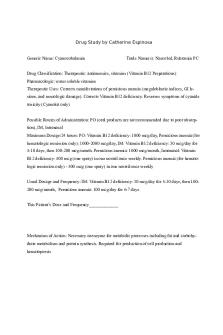Cyanocobalamin Drug Study PDF

| Title | Cyanocobalamin Drug Study |
|---|---|
| Author | Catherine Espinosa |
| Course | fundamentals of nursing |
| Institution | Raritan Valley Community College |
| Pages | 2 |
| File Size | 70.9 KB |
| File Type | |
| Total Downloads | 107 |
| Total Views | 162 |
Summary
Download Cyanocobalamin Drug Study PDF
Description
Drug Study by Catherine Espinosa
Generic Name: Cyanocobalamin
Trade Name(s): Nascobal, Rubramin PC
Drug Classification: Therapeutic: antianemics, vitamins (Vitamin B12 Preparations) Pharmacologic: water soluble vitamins Therapeutic Uses: Corrects manifestations of pernicious anemia (megaloblastic indices, GI lesions, and neurologic damage). Corrects Vitamin B12 deficiency. Reverses symptoms of cyanide toxicity (Cyanokit only)
Possible Routes of Administration: PO (oral products are not recommended due to poor absorption), IM, Intranasal Maximum Dosage/24 hours: PO: Vitamin B12 deficiency: 1000 mcg/day, Pernicious anemia (for hematologic remission only): 1000-2000 mcg/day, IM: Vitamin B12 deficiency: 30 mcg/day for 5-10 days, then 100-200 mcg/month. Pernicious anemia: 1000 mcg/month, Intranasal: Vitamin B12 deficiency: 500 mcg (one spray) in one nostril once weekly. Pernicious anemia (for hematologic remission only) - 500 mcg (one spray) in one nostril once weekly
Usual Dosage and Frequency: IM: Vitamin B12 deficiency: 30 mcg/day for 5-10 days, then 100200 mcg/month, Pernicious anemia: 100 mcg/day for 6-7 days
This Patient’s Dose and Frequency_____________
Mechanism of Action: Necessary coenzyme for metabolic processes including fat and carbohydrate metabolism and protein synthesis. Required for production of cell production and hematopoesis
Adverse Effects: headache, diarrhea, itching, hypokalemia, thrombocytosis, pulmonary edema, pain at IM site, ANAPHYLAXIS
Nursing Implications: • Assess patient for signs of vitamin B12 deficiency (pallor, neuropathy, psychosis; red inflamed tongue) before and periodically during therapy. • Lab Test Considerations: Monitor plasma folic acid, vitamin B12, and iron levels, Hgb, Hct before treatment, 1 mo after start therapy and then every 3-6 mo. Evaluate serum potassium level in patients receiving vitamin B12 for pernicious anemia for hypokalemia during the first 48 hr treatment. Serum potassium and platelet counts should be monitored routinely during the course of therapy. •
PO: Administer with meals to increase absorption
•
Intranasal: Dose should not be administered within 1 hr of hot food or liquids (nasal secretions may decrease the effectiveness of the nasal spray)
•
IM: Vials should be protected from the light
Patient Teaching: •
Encourage patient to comply with diet recommendations of health care professional.
•
Foods high in Vitamin B12 include meats, seafood, egg yolk, and fermented cheeses
•
Inform patients with pernicious anemia of the life long need for vitamin B12 replacement
•
Intranasal: Instruct patient in proper administration and technique
•
Intermittent infusion: Advise patient that skin redness may last up to 2 wks an their urine may remain red up to 5 wks after drug administration...
Similar Free PDFs

Cyanocobalamin Drug Study
- 2 Pages

Olanzapine Drug Study
- 3 Pages

Drug Study Kayexalate
- 3 Pages

Clopidogrel Drug Study
- 3 Pages

Methylprednisolone Drug Study
- 2 Pages

Potassium Chloride Drug Study
- 2 Pages

Amlodipine Drug Study
- 2 Pages

Cilostazol Drug Study
- 2 Pages

Simvastatin Drug Study
- 3 Pages

Furosemide Drug Study
- 2 Pages

Carvedilol Drug Study
- 2 Pages

Doxycycline IVPB Drug Study
- 2 Pages

Cef Triaxone Drug Study
- 2 Pages

DRUG Study work
- 2 Pages

Nystatin Drug Study
- 2 Pages

Polyethylene glycol Drug Study
- 2 Pages
Popular Institutions
- Tinajero National High School - Annex
- Politeknik Caltex Riau
- Yokohama City University
- SGT University
- University of Al-Qadisiyah
- Divine Word College of Vigan
- Techniek College Rotterdam
- Universidade de Santiago
- Universiti Teknologi MARA Cawangan Johor Kampus Pasir Gudang
- Poltekkes Kemenkes Yogyakarta
- Baguio City National High School
- Colegio san marcos
- preparatoria uno
- Centro de Bachillerato Tecnológico Industrial y de Servicios No. 107
- Dalian Maritime University
- Quang Trung Secondary School
- Colegio Tecnológico en Informática
- Corporación Regional de Educación Superior
- Grupo CEDVA
- Dar Al Uloom University
- Centro de Estudios Preuniversitarios de la Universidad Nacional de Ingeniería
- 上智大学
- Aakash International School, Nuna Majara
- San Felipe Neri Catholic School
- Kang Chiao International School - New Taipei City
- Misamis Occidental National High School
- Institución Educativa Escuela Normal Juan Ladrilleros
- Kolehiyo ng Pantukan
- Batanes State College
- Instituto Continental
- Sekolah Menengah Kejuruan Kesehatan Kaltara (Tarakan)
- Colegio de La Inmaculada Concepcion - Cebu